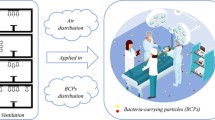Summary
During the use of a vertical flow enclosure of our own design for almost five years, bacteriological studies and the infection rates in different groups of patients have taught us the following:
1. In a clean room operating theatre, the use of a respired air exhaust system improves the sterility compared with the use of ordinary masks. In a vertical flow enclosure, the chest, the arms, and the hands of the team are contaminated from respired airborne bacteria if helmets, etc., are not worn.
2. In our vertical flow enclosure with almost continuous absolute sterility of the air, the infection rate in primary total hip replacement is very low and less than 1%, including early and late infections. Antibiotics have not been used.
In secondary surgery, i.e., total hip replacement in hip joints previously operated upon, the infection rate is markedly higher, probably because of a flare-up of latent infection.
“Clean room” surgery therefore, can only prevent air borne contamination, and no more; but this is very valuable.
3. Vertical flow enclosures of the Charnley-Howorth (1975) and Weber et al. (1971) type provide considerable improvement in sterility of the air compared with adaptations of more conventional theatres. We recommend that these facilities be made available for implant surgery. It is also necessary to have a stringent operational policy with cooperation and discipline on the part of all members of the theatre team.
Résumé
Durant l'utilisation, depuis plus de 5 ans, de la serre stérile à flux laminaire vertical que nous avons construite, nous avons pratiqué des études bactériologiques et pu comparer les taux d'infection suivant les groupes de patients.
1. Dans une salle d'opération “propre”, la stérilité est considérablement améliorée par le port de casques possédant un système d'aspiration de l'air expiré, ceci par rapport au port de masques ordinaires. De plus, si l'on ne porte pas le casque dans une serre à flux laminaire vertical, le tronc, les mains et les membres supérieurs de l'équipe chirurgicale sont contaminés par les microbes en suspension dans l'air expiré.
2. Dans notre serre où l'air est pratiquement stérile, le taux d'infections précoces et tardives est inférieur à 1% dans les arthroplasties de la hanche, et cela sans utilisation d'antibiotiques.
Lors d'interventions dites secondaires, c'est-à-dire dans les cas déjà opérés au préalable, par exemple par ostéotomie, ostéosynthèse, etc., le taux d'infection est plus élevé. On doit probablement en rechercher la cause dans une contamination de la plaie lors de la première intervention, l'infection alors à l'état latent pouvant se réveiller à la faveur d'une nouvelle opération.
En opérant dans une serre stérile, on peut donc prévenir la contamination par l'air ambiant, mais pas plus. Cela est cependant déjà très appréciable.
3. Comparées aux salles d'opération conventionnelles modernes, les serres stériles à flux laminaire vertical, comme celle de Charnley-Howorth (1975) et Weber-Meierhans (1971), améliorent considérablement la stérilité de l'air. Surtout pour la chirurgie prothétique de la hanche, dont les risques d'infection sont élevés, nous recommandons l'emploi de ce genre d'installation. Mais il est nécessaire que tous les membres de l'équipe chirurgicale adoptent des règles très strictes de discipline.
Similar content being viewed by others
References
Charnley, J.: Post-operative infection after total hip replacement with special reference to air contamination in the operating room. Clin. Orth.87 167 (1972)
Janssen, R.: Sterilitätsuntersuchungen in verschiedenen Operationssälen. 35. Kongr. Schweiz. Ges. f. Orthop., 1975
Meierhans, R., Weber, B. G.: Möglichkeiten und Grenzen der Asepsis im Operationssaal. Medica1 31 (1971)
Müller, M. E.: Il trattamento dell'aria condizionata nelle “Salle d'operation blanche”. Bolletino AO8 63 (1972)
Wanner, H. U., Russenberger, H. J.: Untersuchungen über den Keim- und Partikelgehalt der Luft in der Operationsboxe der Orthopädischen Klinik des Kantonsspitals St. Gallen. Bericht des Inst. f. Hyg. und Arbeitsphysiol. Eidg. Techn. Hochsch. Zürich, 25. 5. 1973
Wanner, H. U., Russenberger, H. J., Klotz, F.: Bestimmung des Partikel- und Keimgehaltes in der Luft von Laboratorien und Operationssälen. Internat. Symp. Reinraumtechnik Zürich, 1972
Weber, B. G., Stühmer, G., Meierhans, R.: Sterile Operationsboxen. Z. Orthop.109 803 (1971)
Whitcomb, J. G.: Laminar flow devices in critical hospital areas. Technical lecture series on industry and microbial contamination control. Stanford University, Palo Alto, Calif., 1969
Author information
Authors and Affiliations
Rights and permissions
About this article
Cite this article
Stühmer, G., Weber, B.G., Meierhans, R. et al. Four and a half years experience with a vertical flow sterile enclosure. International Orthopaedics 1, 95–99 (1977). https://doi.org/10.1007/BF00576310
Issue Date:
DOI: https://doi.org/10.1007/BF00576310




